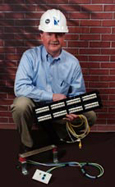Areas of Focus
Technology today does not sit in its own world. It interfaces with other technology and requires complex infrastructure and support systems to be effective. The difficulty comes with integrating the pieces together when stakeholders understand their own systems but not the touch points between them or how to properly coordinate and implement a global set of requirements or their underlying infrastructures. On top of these challenges come resource and schedule pressures and even inter-organizational dysfunction. This is where I come in.
My specialty is pulling multidiscipline technology projects together and successfully implementing them across technical and non-technical, internal and external organizational boundaries. The process starts with a needs collection and analysis, moves on to design professional selection, continues with a close management of the design process and finishes up with contractor selection, implementation, commissioning, documentation and acceptance. Typically I become the chair of a technology committee that has the charter to extract and communicate the requisite information in a comprehensive and coordinated fashion.
Design coordination and implementation management services
 The
following categories represent typical technology types that need
help.
The
following categories represent typical technology types that need
help.
- Low voltage voice, data, video and controls cabling infrastructures.
Today's technologies require robust and reliable cabling infrastructures. Given the multiple duties they are required to perform these new generation structured cabling systems of fiber and copper must be precisely engineered, expertly procured, professionally installed and rigorously tested to the strictest of industry standards. Without the proper infrastructure design and oversight, the investments you make in information technologies will not live up to their potential or worse, not work at all. - Technology physical infrastructures.
All technology systems need appropriately configured spaces, cabling pathways, critical power systems, grounding, HVAC and telecommunications carrier systems. The good news is that industry standards and well-documented best practices are available that govern the design and installation of these infrastructures. The bad news is that many architects, engineers and clients are unaware that these standards exist and so are prone to make errors that are expensive and time consuming to remedy. - Electronic security systems.
In the post 911 world the emphasis on electronic security has become increasingly important. Systems today are server based, highly integrated and have multiple sub-systems including access control, electronic surveillance, camera monitoring/control and emergency communications systems. These systems are made up of components from multiple manufacturers and require external support including reliable power, secure pathways, electronic locking and cooperation from code officials to make them effective. - Audiovisual systems.
Gone are the days where an overhead projector was the mainstay of executive presentations. The current state of the art audiovisual systems include video projectors, wireless microphones, multichannel mixers, touch screen controls, backbone transport facilities, video teleconferencing, HD multiscreen, surround sound and mutisource feed systems. The impact of this equipment on the infrastructure is substantial not to mention the typical need to interface it to the voice, data and security systems. - Public wireless carrier coverage enhancement systems.
Lower transmitter power factors, low-e glass and dense building cores have combined to reduce cellular voice and data coverage to the point that it can no longer be useful inside. Systems are available that can improve the quality and reliability of cellular voice and data services to these "RF unfriendly" cores and shells. - Outdoor antenna systems.
Satellite antennas, HD off-air antennas and cellular enhancement system antennas all need careful placement, infrastructure design and coordination with the landlord and community zoning boards.
Technology Planning and Support Services
- Comprehensive pre-development and programming development coordination with stakeholders, developers, engineers and architects
- Chairing of multidiscipline technology committeesto ensure a coordinated, consistent approach between client, design professionals and developer
- Specification development and construction document coordination including regularly scheduled detailed design reviews
- Bid development and award coordination
- Utility coordination
- Technology systems construction management
- Commissioning plan development and test plan results collection and analysis
- Client-consultant-contractor communications and issue resolution coordination
- Change order administration, analysis and negotiations
- Punch list generation and administration and project closeout.
Value Added Services
As part of my basic design and implementation coordination activities I work closely with clients, architects and engineers to review "constructability" and suitability of technology and technology infrastructure designs and to identify value engineering and cost saving alternatives. This work is in addition to validating that designs are well matched to the tenant's and owner's needs and ensuring that the delivered projects conform to plans, specifications, budget, schedule and code.

